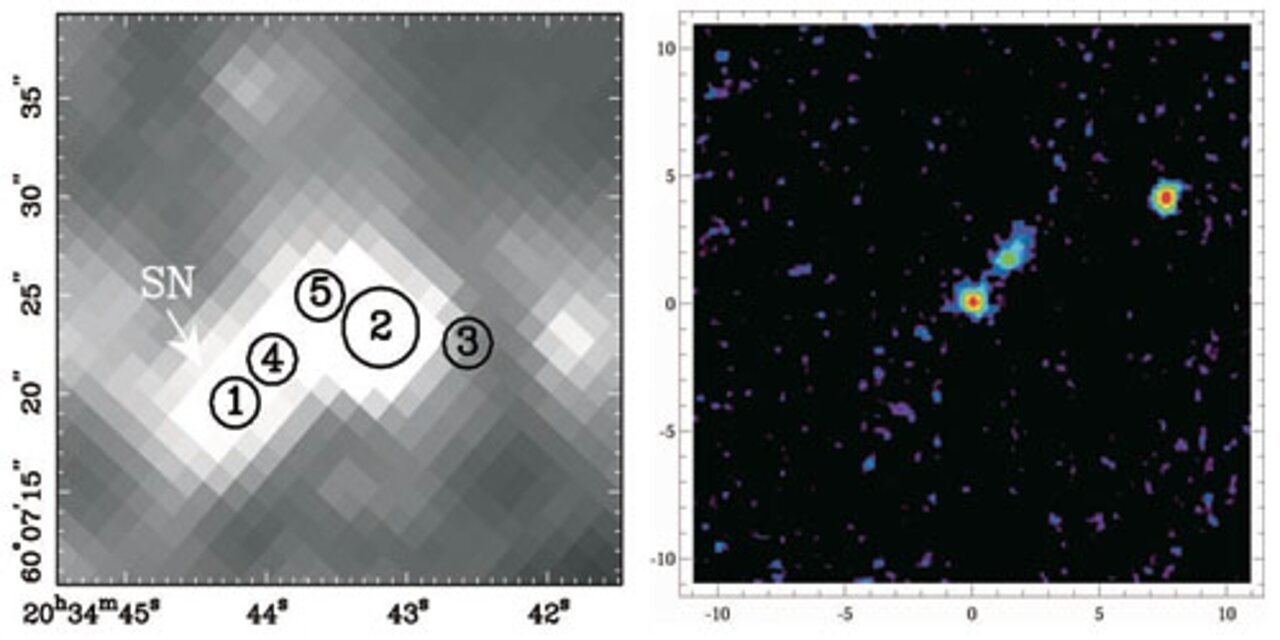Mid-infrared Dust Emission from Massive-Star Supernovae
June 28, 2005

Imaging by Gemini North's Michelle mid-infrared imager/spectrograph has allowed an international team of researchers to isolate and characterize the dusty remains of the supernova remnant SN 2002hh some 20 million light-years away. Led by UK astronomer Michael Barlow (University College London), the team imaged SN 2002hh in the relatively nearby galaxy NGC 6946 to study the dust expelled (and/or created) during the supernova explosion. Earlier Spitzer Space Telescope observations identified the dust excess from the supernova as part of the Survey for Evolution of Emission from Dust in Supernovae (SEEDS) project using Spitzer Infrared Nearby Galaxy Survey (SINGS) Legacy data set. However, due to a lack of spatial resolution, these observations failed to confirm the identity of Source 1 (see Figure 1) as the supernova. The new Gemini results provided an approximately ten-fold increase in resolution at 11.2 and 18.5 microns and were able to clearly isolate the supernova source from its neighbors (Figure 2).
The mid-infrared spectral energy distribution (SED) of SN 2002hh matches a source that radiates like a 290 K blackbody with a radius of 0.1 light-year (or, alternatively, like a 225 K source with an inverse-wavelength emissivity and a radius of 0.5 light-year). Since it would require 25 years for supernova ejecta expanding at 6,000 kilometers per second to reach the latter radius, Barlow and his team concluded that the dust must have originated from an earlier mass-loss phase of the supernova progenitor.
Radiative transfer models using these data indicate a total gas and dust mass in the shell of at least ten solar masses.[1] The derived dust mass of at least 0.1 solar masses is similar to those estimated for the dust shells around the self-obscured red supergiant NML Cygni and the luminous blue variable AG Carinae, suggesting that the precursor of SN 2002hh may have been similar to one of these massive precursors.
Models confirm that newly formed dust in supernovae ejecta should become detectable at mid-infrared wavelengths within two years of an outburst. They also prove that the mid-infrared is particularly suitable to trace the onset of dust formation in supernovae, and to determine the amount of dust formed. Supernova 1987A was an unusually close one (see background information box) and mid-infrared studies of other extragalactic supernovae have not been possible until recently. With the advent of ground-based 8-meter telescopes equipped with sensitive mid-infrared instruments such as Michelle and TReCS, and the launch of the Spitzer Space Telescope, sufficient sensitivity has become available to embark on searches for mid-infrared emission from supernovae in nearby galaxies.
Observations were obtained using Director’s Discretionary Time on September 26, 2004. For more details, see the paper "Detection of a Massive Dust Shell around the Type II Supernova SN 2002hh" by M. J. Barlow, B. E. K. Sugerman, J. Fabbri, M. Meixner, R. S. Fisher, J. E. Bowey, N. Panagia, B. Ercolano, G. C. Clayton, M. Cohen, T. M. Gledhill, K. Gordon, A. G. G. M. Tielens, and A. A. Zijlstra, to appear in the Astrophysical Journal Letters, and the article "Mid-infrared Dust Emission from Massive Star Supernovae" in GeminiFocus, vol. 25, pp. 16-18, June 2005.
Supernovae as Suppliers of Cosmic Dust
The violent explosions of massive stars as supernovae could well be a major, or even the dominant, source of dust in the universe. This idea is indirectly supported by the fact that many of the earliest-formed galaxies known are extremely dusty and luminous in the infrared. It seems that only massive stars can have produced the observed dust over the short timescales implied, either during dusty mass-loss phases prior to the explosion, or else within the expanding and cooling ejecta from the supernova. The evidence for this comes from the efficient detection of their redshifted dust emission at submillimeter wavelengths by the Submillimeter Common-User Bolometric Array (SCUBA) and other instruments.
Supporting evidence for dust formation by at least some supernovae comes from precise studies of the ratios of chemical isotopes that make up the grain inclusions found in meteorites. Many of these inclusions exhibit isotopic distributions that differ significantly from those found in the Sun and Earth, and have consequently been labeled as “presolar” grains, or “stardust.” Some of these grains have isotopic distributions characteristic of the r-process that operates inside supernovae and is responsible for the synthesis of heavier elements during such an event. The first direct observational evidence for the formation of dust by supernovae came from studies of SN 1987A in the Large Magellanic Cloud. Mid-infrared emission from warm dust grains that formed in the ejecta from this supernova became evident from about 500-600 days after the outburst. The same dust produced about 0.6 magnitudes of optical extinction as deduced from red-blue asymmetries that developed in the profiles of optical emission lines. The red-shifted emission from the far side of the ejecta suffered more extinction than the blue-shifted emission from the near side.
Notes
[1] The dust and gas mass estimate of 10-15 solar masses is based on applying a standard ISM gas/dust ratio of 100 to the derived dust mass of 0.1-0.15 solar masses for SN 2002hh. The comparison to NML Cyg in particular can only be between their dust shell masses since the total gas around SN 2002hh and NML Cyg has not been measured.

